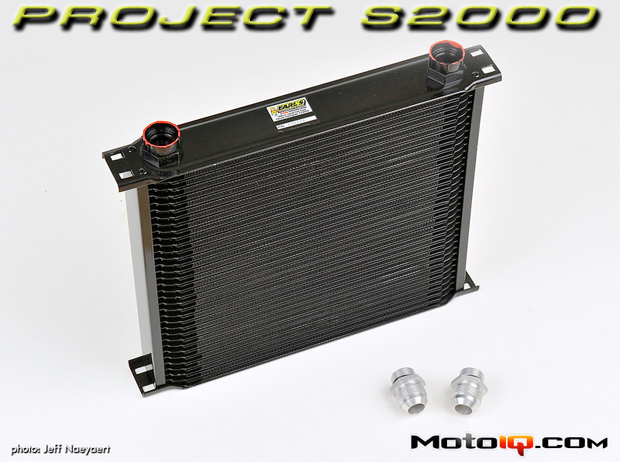,
 |  |
| Views of the installed Earl’s oil cooler from both sides. The Ano-Tuff fittings and Pro-Lite 350 hose are -12AN size. I went as big as possible to minimize pressure drop. |
There are a few other benefits to mounting the oil cooler behind the radiator. One is that the oil lines are shorter resulting in less pressure drop. Another is that the oil gets pre-heated by the warm air coming off the radiator. Remember that one of the functions of the stock donut was to heat up the oil faster from a cold start. The coolant comes up to temperature much quicker, so now the warm air coming off the radiator will warm up the oil in the oil cooler before the thermostat opens. Once the thermostat does open, the oil will already be warmed up a bit as opposed to being cold.
 |
| The oil lines are routed under the chassis cross member to the Mocal adapter. |
Being behind the radiator meant there was more space for the bigger oil cooler; the size I chose holds almost a quart of oil bringing the total oil capacity up to 6 quarts from 5 quarts. I should note a bigger cooler is required because it’s getting warmed air off the radiator instead of fresh cool air from the front of the car. As the passenger side fan is now attached directly to the oil cooler, it’s like a built-in cooling fan. If the oil temps are warm when coming off the track, all I have to do is turn on the A/C (with the temp set to full hot) which will kick on the fan and pull air through the oil cooler.
There are two more advantages I can think of. As the oil cooler is somewhat heavy (it is filled with a quart of oil), placing it closer to the center of the car reduces the overall polar moment of inertia as compared to placing the cooler at the front of the car. Lastly, the oil cooler is protected from road debris and front end collisions.
So there you have it, my oil cooler install. It’s a little unconventional, but I think it has a good number of advantages over a front mounted oil cooler setup. So far, I’ve only had a chance to crank it up and check for leaks. I do know it will cool the oil down. The unknown is how much the oil will get cooled. But like I said before, better to have the oil too hot instead of the coolant. Oh yeah, the coolant should be cooler now because it no longer has to cool the oil. Double win! Stay tuned for performance numbers.
Sources




17 comments
Why did you choose such a big oil cooler? the aftermarket does not offer such large applications.
Does it have to do with the flow rate of the s2000’s oil pump at high rpm?
I have oil cooler setrab of 18 lines and I see that after 5 minutes on the track the pressure drops to 64psi in vtect and the temperature to 233f
my car is supercharger kraftwerks and the oil cooler is located behind the supercharger intercooler
thanks
Part of the reason was because I put the oil cooler behind all the other heat exchangers, so it was getting the hottest air. Check out the article that is Part 23: Testing air temps through coolers and vents. I also only had one chance to do this setup without testing various combinations, so I went large to be safe. The benefits being more cooling, greater oil capacity, and less pressure drop. I don’t think I’ve ever seen below 75-80psi in the VTEC transition with oil temps at 240F.
my car have kraftwerks kit, please recommend configuration for oil cooler
Use an oil cooler with more rows. The greater number of rows, the lower the pressure drop and the more cooling. Also, what size lines are you using? I’m using -12. Lots of kits use -8 which is too small in my opinion. I would say at least -10.
Why does a greater number of rows equate to a lower drop in oil pressure? Is it because the greater number of rows allows for more paths for the oil to flow and thus less restriction to flow? Also, If I were to take a 30 row oil cooler core and make it into a triple pass where each pass has 10 rows, would that create a pressure drop equivalent to using a 10 row single pass cooler?
Pressure drop is a function of velocity and distance. Pressure drop increases to the square of velocity. And the longer the distance, the greater the pressure drop. So with more rows, you have more flow area, which reduces the velocity for the same mass flow rate.
A 10-row single pass would have less pressure drop than a 30-row triple pass, assuming the cores are the same width. This is because in the 30-row triple pass, the flow distance is triple the 10-row assuming the cores are the same width. And there’s going to be additional pressure drop each time the oil has to make a turn in the triple pass.
Ok that makes sense. Thank you!
what oil use in your car?
Motul 300V 5w-30
I use a line of 16 lines behind the intercooler of my kraftwerks kit and the car easily goes up to 240f.
ask, if I add one of 42 lines behind the radiator with a fan, the temperature will I be able to control it better? What do you recommend doing to keep control of the oil temperature of my car?
The water temperature is stable at 220f
Bigger oil cooler will certainly help. But you also need to address your coolant temps which are too high. Consider that that fans turn on at 212F. Sure, you CAN run at 220F, but it reduces the reliability of your engine and hurts power. My car is naturally aspirated, but coolant never goes over 190F even when I did track days in 103F temps. Make sure you have your heat exchangers well sealed (I used foam stuffed around them) and you certainly need a vented hood if you don’t have one already.
hello I have a question I am using the original car water radiator thermostat, would you recommend changing the sensor to a mishimoto of less temperature? I use the street car too
No, changing to a lower temp thermostat does nothing for reducing temps at steady state conditions. It just delays how quickly the temp will max out.
A friend suggested to me a rather convelling idea about oil cooling: If for example we keep the original donut (oil cooler) to circulate water (circuit with a radiator on the bumper, and an electric pump that activates with a mano connected to the oil temperature) .. What do you think?
Yup, should work just fine. Keep in mind the OEM setup is circulating 190degF coolant. If you have a separate circuit with front mounted radiator, it should cool the coolant down close to ambient. So figure it’ll be at least 80degF cooler coolant compared to the OEM setup. You might need a variable speed pump to regulate the oil temp and not cool it too much under everyday driving conditions.
Any updates on how this is performing at the track? How is the oil temperature holding up?
https://motoiq.com/project-s2000-track-testing-revised-kw-clubsports-and-earls-oil-cooler/
https://motoiq.com/project-s2000-part-19-ram-air-plus-hot-air-testing/6/